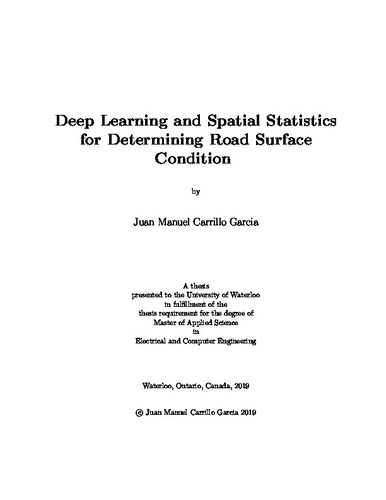| dc.contributor.author | Carrillo Garcia, Juan Manuel | |
| dc.date.accessioned | 2019-08-28 14:11:47 (GMT) | |
| dc.date.available | 2019-08-28 14:11:47 (GMT) | |
| dc.date.issued | 2019-08-28 | |
| dc.date.submitted | 2019-08-21 | |
| dc.identifier.uri | http://hdl.handle.net/10012/14969 | |
| dc.description.abstract | Machine Learning (ML), and especially Deep Learning (DL) methods, have evolved
rapidly over the last years and showed remarkable advances in research areas such as computer
vision and natural language processing; however, there are still engineering applications
in industries such as transportation where DL methods have not been applied yet or that
can be benefited from an integrated approach using DL in addition to other methods.
For countries in Northern latitudes, one of such applications is Monitoring Road Surface
Condition (RSC) during the Winter season for improving road safety and road maintenance
operations.
In this study, we introduce a novel approach for monitoring of RSC that integrates
DL methods and Spatial Statistics (SS) to simultaneously process data from roadside
cameras and weather stations to determine automatically the category of snow coverage
at sample locations across a region of interest. Our approach integrates the advantages of
SS for interpolating spatial variables and the strengths of DL for Computer Vision tasks,
particularly for image classification. On one hand, SS models serve to understand the spatial
autocorrelation of random variables and to determine their expected values in unsampled
locations based on a number of near observations. On the other hand, DL models extract
relevant patterns from a large number of training images and learn a mapping from input
images to a set of predefined labels.
We implement and evaluate our approach using data collected in the province of Ontario
during the 2017-2018 Winter season. Specifically, we included data from three separate
sources, Environment Canada (EC) Weather stations, Road Weather Information System
(RWIS) stations, and roadside cameras from the Ministry of Transportation of Ontario
(MTO). To the best of our knowledge, this is the first study that integrates both DL and
SS techniques for processing the three data sources with the goal of monitoring RSC.
The DL models we implement and compared are Inception, Inception-Resnet, Xception,
DenseNet, MobileNetv2, and NASNet. All of these models have achieved remarkable
results for image classification in well-known benchmarks. The SS models we evaluate are
Ordinary Kriging (OK), Radial Basis Functions (RBF), and Inverse Distance Weighted
(IDW). The first provides a comprehensive understanding of the spatial autocorrelation
for each particular variable, while the second and third allow a faster implementation. Our
integrated approach works by combining the output feature vector from the DL model with
the interpolated values from the SS model to output a more robust prediction of RSC for
the locations of interest. | en |
| dc.language.iso | en | en |
| dc.publisher | University of Waterloo | en |
| dc.subject | Deep Learning | en |
| dc.subject | Machine Learning | en |
| dc.subject | Spatial Statistics | en |
| dc.subject | Computer Vision | en |
| dc.subject | Road Surface Condition | en |
| dc.subject | Intelligent Transportation Systems | en |
| dc.title | Deep Learning and Spatial Statistics for Determining Road Surface Condition | en |
| dc.type | Master Thesis | en |
| dc.pending | false | |
| uws-etd.degree.department | Electrical and Computer Engineering | en |
| uws-etd.degree.discipline | Electrical and Computer Engineering | en |
| uws-etd.degree.grantor | University of Waterloo | en |
| uws-etd.degree | Master of Applied Science | en |
| uws.contributor.advisor | Crowley, Mark | |
| uws.contributor.affiliation1 | Faculty of Engineering | en |
| uws.published.city | Waterloo | en |
| uws.published.country | Canada | en |
| uws.published.province | Ontario | en |
| uws.typeOfResource | Text | en |
| uws.peerReviewStatus | Unreviewed | en |
| uws.scholarLevel | Graduate | en |

